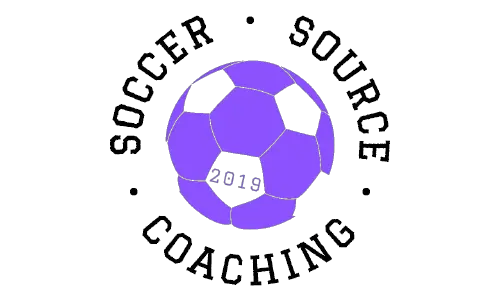You can easily tell whether or not a soccer team has worked on its defensive shape. Teams that have worked on their defensive shape are well organized, the players know their roles and are extremely difficult to break down and this, in turn, will help them win more games. These soccer drills that work on the defensive shape will help your team do the same!
Before beginning these soccer drills that work on the defensive shape you want to ensure that your team is comfortable defending 1v1 scenarios as this will provide your players with a strong foundation of defending knowledge moving forward.
Download these drills as a PDF at the bottom of the page
7 Defensive Shape Soccer Drills
2v2 soccer drill for defensive shape
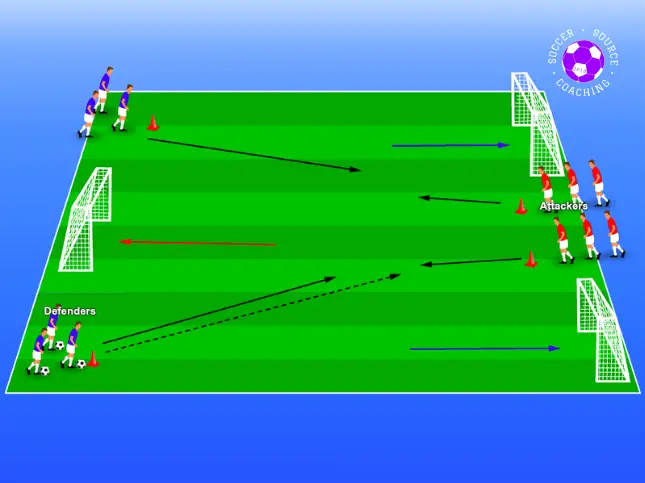
Purpose:
The purpose of this drill is to help players understand defend how to themselves as a pair. This could reflect a winger tracking back to help his full-back in a game scenario.
Set up:
- 20 x 15-yard area
- 3 soccer balls
- Three pairs of attackers
- 3 pairs of defenders
- 3 goals
- 4 larger cones to mark as starting points
Instructions:
Set up your area and place one goal in the middle of the 20-yard line, with 2 other goals in the corners of the opposite 20-yard line.
Place 2 larger cones 5 yards on either side of the goal in the middle, this is where the defenders will start, and 2 larger cones 2 yards inside from the goals in the corners, this is where the attackers will start.
Divide your players into 3 defending pairs and 3 attacking pairs.
The defending pairs will start with the ball and pass the ball to the attackers.
The attackers must try to score in the one goal with the defenders trying to steal the ball and score in the 2 goals opposite.
If the attackers score they will get 1 point.
If the defenders score they will get 3 points.
The phase of play will come to an end when the ball goes out of bounds or a goal is scored, with the next defending pair passing the ball to the next attackers.
Coaching points:
- The defender closest to the ball should pressure the attacker
- The defender closest to the ball should position themselves where they are showing the defender away from the goal and cutting off their passing option
- Make sure that the other defender is behind the defender pressuring to cover
Questions that can lead to coaching points:
- Which defender should pressure the attacker with the ball?
- How should the defenders position themselves when pressuring the defender?
- If one defender is pressured where should the other defenders position themselves?
4v2 rondo that works on defensive shape
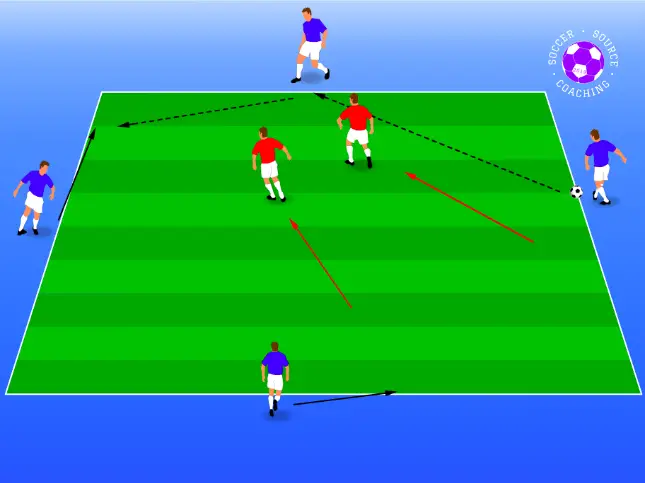
Purpose:
The purpose of this soccer rondo drill is to help defenders work together as a pair to stop passes that can break defensive lines.
Set up:
- 2, 10 x 10-yard area
- 1 soccer ball
- 6 players per area
Instructions:
Set up your areas and divide your players into 2 teams of 6.
2 players from each team will move over to the opposing teams’ areas and act as defenders.
The two teams will be competing against each other to see who can split the defenders the most with a pass (successfully passing the ball between the defenders to a teammate).
If the defenders win the ball back they must try to keep the ball.
2 players from the possessing team can try to win the ball back in the area, this creates a 2v2.
They will regain possession of the ball either when they win it back and pass it to a teammate or when the ball goes out of the area touching a defender last.
The winning team will be the team that has split the 2 defenders the most.
Make sure there are at least 3 rounds so everyone has an opportunity to become the defenders.
Coaching points:
- Communicate as a pair, the player closest to the ball should press while the other defender should cover
- The player pressing should use their positioning and body shape to force the possessing player to pass in a certain direction
- Transition quickly from defending to possessing and vice versa.
Questions that can lead to coaching points:
- How do you know who should press and who should cover?
- How can you dictate where the possessing player passes the ball?
- What should you be thinking/doing when there is a change in possession?
Waves soccer drill for defensive shape
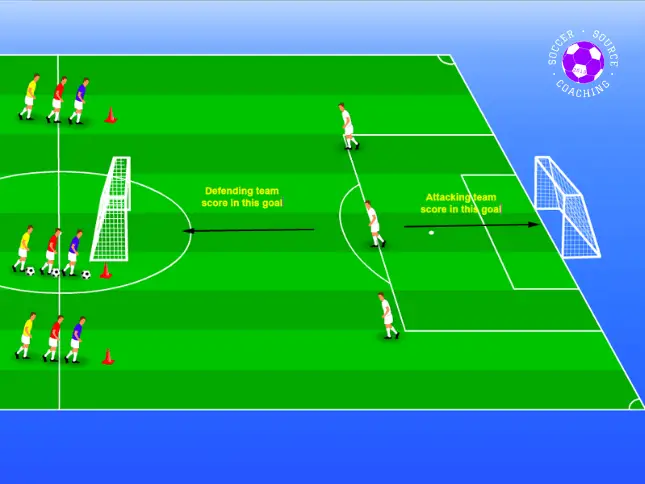
Purpose:
the purpose of this defensive shape drill is to get players transitioning quicker from attack and into their defensive shape.
Set up:
- 25 x 40-yard area
- 4 soccer balls
- 2 goals
- 4 teams of 3
Instructions:
Set up your area with your 2 goals opposite each other and in the middle of the 25-yard line.
Divide your players into 4 teams of 3 with each team having a soccer ball.
All the teams will start behind one goal to try to score in the goal opposite them.
The first team of 3 will combine passes unopposed and take a shot on the goal, as soon as the goal is scored or the ball goes out of bounds they will become the defending team as the next attacking team comes into play.
If the defending teams can steal the ball they can try to score in the goal where the attackers start from.
The next attacking team can start their attack when the end of the previous phase, either through the ball going out of bounds or the goal being scored.
The winning team will be the team that scores the most goals.
Coaching points:
- React quickly to the transition with the closest player pressuring the attacking player with the ball
- Stand the player up this will allow time for your teammates to get back in a better defensive position.
- The other defenders should be staggered and in a position to cover the defender covering the ball
Questions that can lead to coaching points:
- Which defending player should pressure the ball?
- How can you bide time for your teammates to get back in a defensive position?
- How should the other defender position themselves if they are not pressuring the attacker with the ball?
End-to-end defending soccer drill
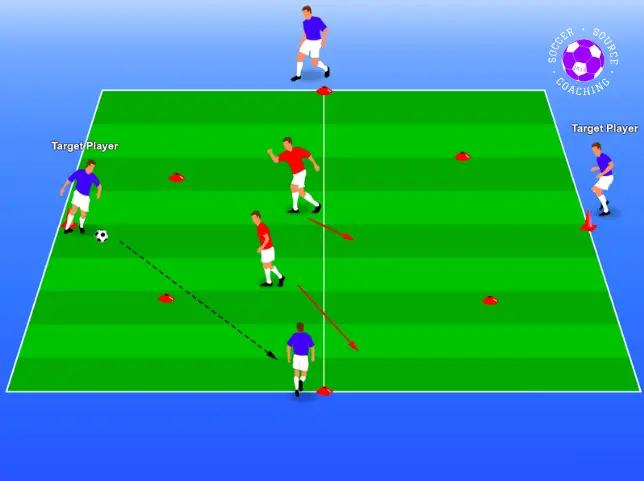
Purpose:
The purpose of this soccer drill is to try to dictate where the possession teams play their next pass.
Set up:
- 10 x 10-yard diamond
- 4 cones (2 red, 2 blue)
- 1 soccer ball
- 4 possessing players (2 target players)
- 2 defenders
Instructions:
Set up your area using the 4 cones making sure that the blue and red cones are opposite each other.
Ask your 4 possessing players to stand on a cone with the two players standing on the red cones becoming the target players.
the 2 defenders in the middle will have to try to stop the ball from being passed between the 2 target players.
There will be 3 rounds of 3 minutes to ensure all the players will be the defenders.
The defending pair that has the most points scored against them will be the losing team.
Coaching points:
- Work as a pair to dictate where the possessing players pass the ball
- Close off passing angles to prevent passes from reaching the target player
- Communicate as a pair, decide who is pressuring the ball and who is covering
Questions that can lead to coaching points:
- How can you contain the players with the ball to prevent them from getting the ball between the target players?
- What can you do as a pair to make it harder for the possession team to get the ball to the target players?
- What should you be constantly doing to ensure that your pressing is effective?
Defensive shape soccer drill when pressing high
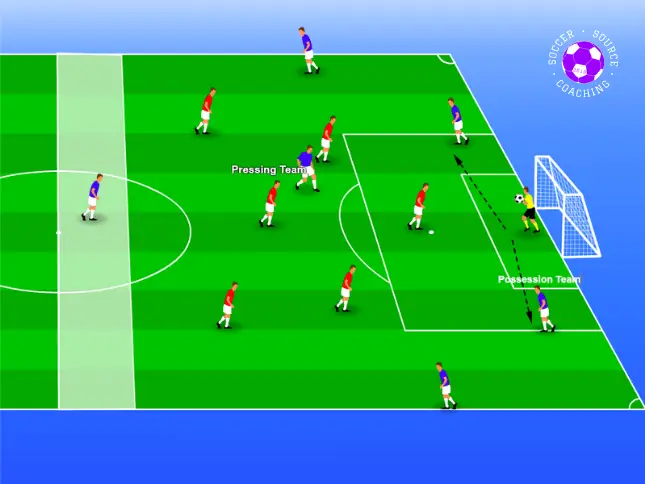
Purpose:
The purpose of this soccer drill is to help your team to remain compact and tough to break down when the opposition has possession of the ball in your half.
Set up:
This setup will largely depend on the age group you are coaching, naturally, if you are coaching a 11v11 team the size of the area will be bigger than if you were coaching a 7v7 team.
- The size of the area should be just over half the size of the field dimensions players use for their age group
- Realistic team sizes for attackers and defenders, for example, the attacking team and defending team should both have 7 players each (or as close to those numbers as possible, depending on the squad size)
- 1 goal
- 1 soccer ball
- End zone for the striker of the defending team to play to (If you do not have enough players then you can set up 3 pug goals instead of an end zone with a striker)
Instructions:
For this drill, the opposition will start with the ball from the goalkeeper.
They must try to beat the press and get the ball to their target player in the endzone on the halfway line.
The opposition team will 1 point if they manage this.
If the pressing team is able to force the opposition out of bounds (regardless of who it touches last) they will get 1 point.
If they can gain possession of the ball and score a goal the goal will be worth 3 points.
Once the phase of play comes to an end (reaching the target player, the goal scored, or out of bounds) the restart will always start from the opposition goalkeeper.
Coaching points:
- Look for triggers to press, such as a bad touch or defenders looking hesitant on the ball
- Players should press together, If one player presses and their teammates do not, then the press will fail.
- Force the defenders to play in certain areas by blocking off passing lanes.
Questions that can lead to coaching points:
- When should you press as a defensive unit?
- What happens if only one person presses instead of the team?
- How can you force defenders to play in certain areas and force mistakes?
Defensive shape drill when defending in your half
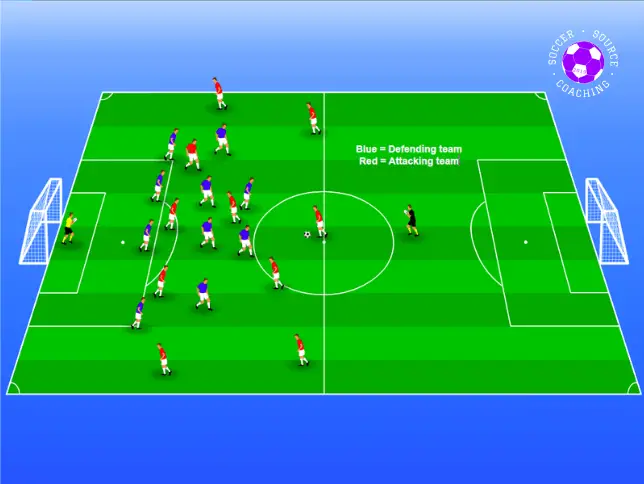
Purpose:
The purpose of this soccer drill is to help teams remain compact and hard to break down when defending deeper and in their half.
Set up:
Similar to the previous drill make sure that the size of the area is appropriate for your team’s age group.
- Full-field/ Half-field (depending on your team’s ages/ numbers for the drill
- 1 soccer ball
- 2 goals
Instructions:
This will be a regular scrimmage however with a greater focus on the defending team shape when they are out of possession.
To help encourage this you can provide the defending team with this scenario:
‘The defending is 1-0 up in a cup final with 5 minutes left to play
By giving them this situation teams will have to adapt depending on the scoreline.
If the defending team can win the ball back encourage them to retain possession or relieve pressure by playing the ball long, allowing them to move up the field.
They can also try to catch opposition team on a counter-attack to score a goal
Coaching points:
- Force the attacking team into the wide areas and back towards their own goal
- Remain disciplined in your position. Know when to press and when to drop off
- Communicate with your teammates, especially when the opposition tries to switch the point of attack
Questions that can lead to coaching points:
- Where should you try to show the defenders?
- How can you stay organized as a team?
- What can you do that will help your team work better together?
Small side soccer game to work on defensive shape
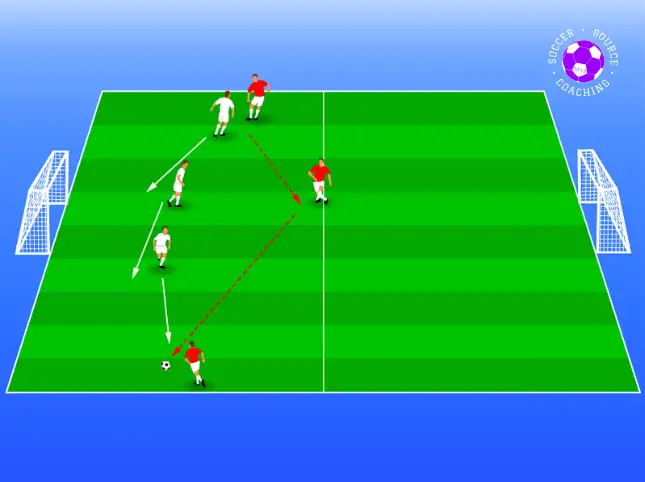
Purpose:
The purpose of this 3v3 small-sided game is to give your players a lot of opportunities to work on defensive shape either in their half or the opposing team’s half with different scoring incentives.
Set up:
- 25 x 45-yard area
- 2 teams of 3
- 2 goals
- 1 soccer ball
Instructions:
This will be a regular game of soccer however you can change the goal-scoring incentives to promote what you want to see from your players.
If you want the players to work on their defensive shape in their opponents’ half then you can introduce a rule where if players can score a goal after winning the ball in their opponents’ half they will get 3 goals instead of 1.
On the other hand, if you want to work on your team’s defensive shape in their half you can introduce a rule where if they can win the ball back in their half and score a goal, that goal will be worth 3 goals instead of 1.
This would be a great drill for a counter-attack in soccer
These are some more great counter-attacking soccer drills
Coaching points:
- Stay organized as a team, everyone must be on the same page when trying to maintain their defensive shape.
- Work as a team to force the opposition to play into certain areas where it will be easier to win the ball back.
- You don’t always have to win the ball to be successful at defending, force the other team into mistakes by applying pressure and cutting off passing angles.
Questions that can lead to coaching points:
- What makes a defensive shape successful?
- How can you win the ball back?
- What can you do to force the other team into mistakes?
if you win the ball in your half opponent’s half and score you get more points.
Conclusion of soccer drills that work on defensive shape
Hopefully, these soccer drills that work on the defensive shape will help your team improve their defense and concede fewer goals.
It is important to remember that you need to help your players understand their roles when they are defending in 2s and 3s.
If they do not understand the concepts then when you go to defend as a team the defensive shape will not be effective, try and look at the bigger picture.
Patience is key!
The 4-4-2 soccer formation is a great formation to teach players their defensive roles and responsibility as it is a simple formation to understand.
If you have any other soccer drills that work on defense let everyone know in the comments, also if you know a coach that would find this post helpful then please share it with them using our social media buttons.
Thank you for reading,
Toby
Related posts:
- 10 defending soccer drills that will stop your team from leaking goals
- Stop the long ball with these soccer drills
- Concede fewer goals from corners with these defending corner tactics
The Youth Soccer Coaching Handbook

Take the stress out of coaching youth soccer with 250+ pre-made soccer sessions and drills, just turn up and coach!
Here’s the breakdown of what you’ll find inside:
- 35 Defending Drills
- 35 Dribbling and 1v1 Drills
- 21 SAQ Drills
- 47 Passing, Control, and Possession drills
- 31 Goalkeeper drills
- 36 Shooting and Finishing drills
- 30 Soccer Games U4 – U8
- 20 Pre-made soccer sessions (90 minutes in length each)
